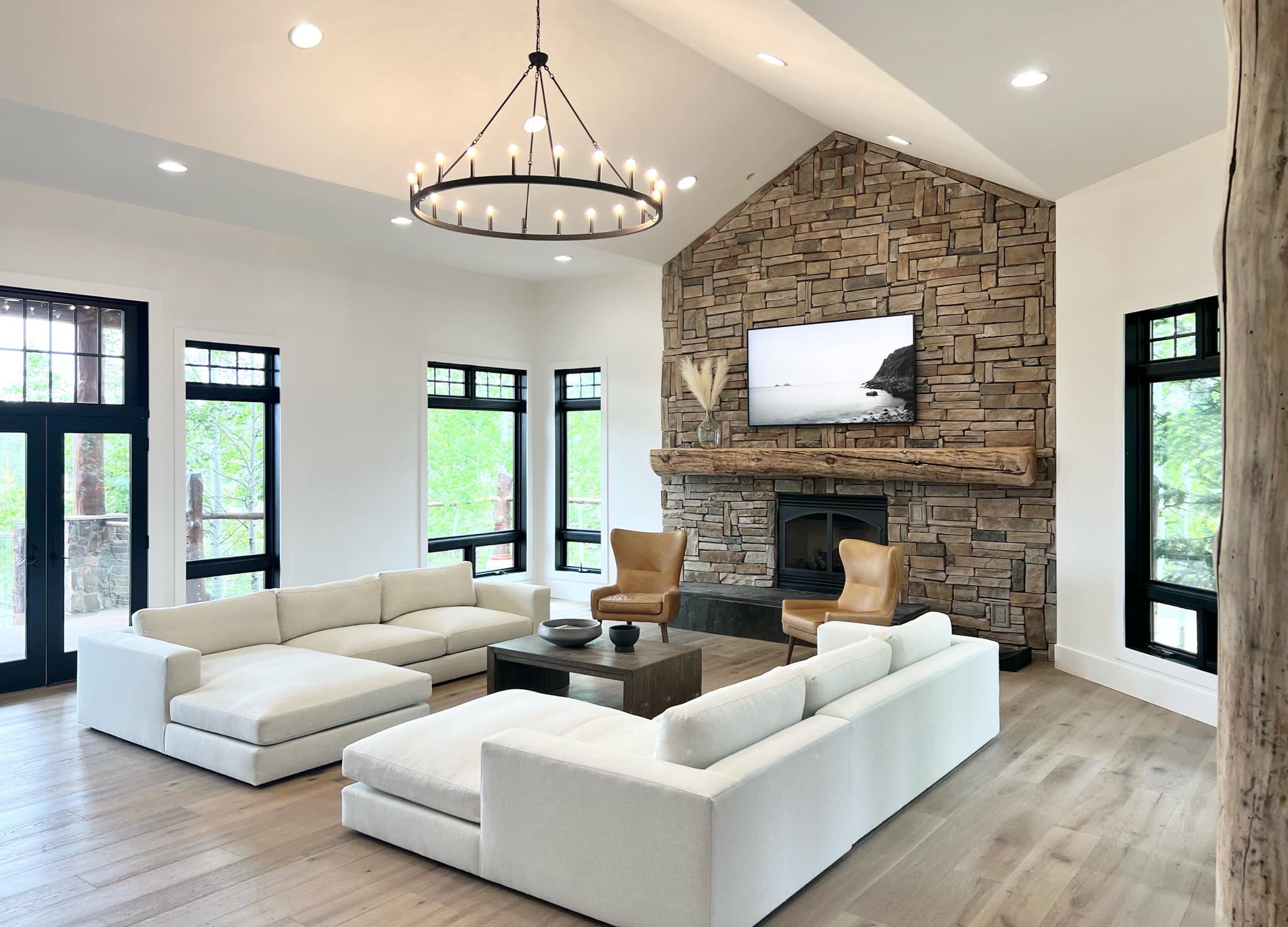Most homeowners focus on color and finish when choosing paint but overlook an equally important factor—air quality. Traditional paints contain harmful chemicals called volatile organic compounds (VOCs) that continue to release toxins long after the paint dries. These chemicals contribute to indoor air pollution, causing potential health risks and lingering odors in your home.
If you want a healthier, odor-free, and eco-friendly living space, low-VOC interior paint is the way to go. This guide will explain why VOCs matter, how low-VOC paint compares to traditional options, and what you should consider when making the switch.
What Are VOCs and Why Should You Care?

Understanding VOCs in Traditional Paints
VOCs are chemicals that evaporate into the air as paint dries. They’re found in many household products, but paint is one of the biggest sources. Some of the most common VOCs in paint include:
-
Formaldehyde – A known carcinogen found in many building materials.
-
Benzene – A toxic compound linked to leukemia and other serious health conditions.
-
Toluene – Causes headaches, dizziness, and long-term neurological issues.
VOCs continue to off-gas for months or even years after application, making indoor air more polluted than you might realize.
How VOCs Affect Indoor Air Quality
VOCs don’t just disappear once your walls dry. They mix with indoor air, becoming trapped inside your home—especially in modern, energy-efficient buildings that limit ventilation.
-
Traps pollutants indoors – VOCs linger in sealed spaces, making indoor air quality worse.
-
Long-term exposure risks – VOCs react with other air pollutants, creating smog-like conditions inside your home.
-
Studies show that indoor air can be 2–5 times more polluted than outdoor air due to VOC buildup.
The Health Risks of High-VOC Paints
Exposure to high levels of VOCs can lead to both short-term and long-term health issues.
Short-Term Symptoms of High-VOC Paints
The effects of VOC exposure can be immediate. Many people experience headaches, dizziness, and nausea shortly after painting. Others may develop eye, nose, and throat irritation, making it uncomfortable to stay in a freshly painted room. Fatigue is also common, leaving you feeling drained without a clear cause.
For those with asthma or respiratory issues, breathing difficulties can set in quickly, making high-VOC paints a serious concern.
Long-Term Risks
The dangers don’t stop once the paint dries. Prolonged exposure to VOCs has been linked to lung disease, neurological disorders, and an increased risk of respiratory illnesses. Some studies suggest a connection between VOC exposure and certain cancers.
In children, long-term inhalation of VOCs may contribute to developmental and behavioral issues. These risks make it crucial to consider what’s in your paint, not just how it looks on your walls.
Who Is Most Vulnerable?
Not everyone reacts to VOCs the same way. Some people are more at risk than others.
-
Pregnant women – Exposure during pregnancy can impact fetal development.
-
Children and babies – Their lungs are still developing, making them more sensitive to airborne pollutants.
-
Elderly individuals – Those with existing respiratory conditions may experience worsened symptoms.
-
People with asthma or allergies – Even low exposure can trigger severe reactions.
Choosing low-VOC paint is more than a preference—it’s a protective measure for the people who need clean air the most.
Why Homeowners Are Switching to Low-VOC Paints

What Makes Low-VOC Paint Different?
Low-VOC paints reduce air pollution and health risks without sacrificing performance. They contain fewer harmful chemicals, lowering airborne toxins in your home.
With minimal off-gassing, VOC emissions are dramatically reduced compared to traditional paints. These paints are available in various finishes—matte, eggshell, semi-gloss, and high-gloss—offering the same aesthetic options as conventional paints.
Improved Indoor Air Quality
Switching to low-VOC paint means a cleaner home with fewer pollutants. It significantly reduces airborne toxins, improving indoor air quality immediately after application.
This is especially beneficial for asthma sufferers, allergy-prone individuals, and those with respiratory sensitivities. Fewer irritants in the air mean fewer symptoms. Low-VOC paints are also safer for babies and pets.
Odor Control for a Fresher Home
Low-VOC paint eliminates the lingering chemical odor of traditional paint. The strong fumes that typically last for days are no longer an issue.
Rooms become usable faster. Bedrooms, nurseries, and living spaces benefit from fresher air without harsh smells.
Environmentally Friendly Choice
Traditional paints contribute to air pollution and smog. Low-VOC alternatives help reduce harmful emissions, making them an eco-friendlier option.
Many brands use biodegradable, sustainable ingredients. Less toxic waste means fewer contaminants in landfills and water supplies.
Addressing Common Homeowner Concerns About Low-VOC Paint
“Is Low-VOC Paint as Durable as Traditional Paint?”
Yes! In the past, low-VOC paints had durability issues, but modern formulations have greatly improved their performance.
-
Scrubbable and stain-resistant – Low-VOC options now offer excellent washability.
-
Strong adhesion – Bonds well to walls for long-lasting coverage.
-
Comparable longevity – Performs just as well as high-VOC paints.
“Are There Fewer Color Choices?”
Not anymore! Today, all major brands offer hundreds of shades in low-VOC options.
-
Custom color mixing available – You’re not limited to a small palette.
-
Rich, deep tones – Advances in pigment technology ensure vibrant colors.
“Will It Cost More?”
Low-VOC paints used to be expensive, but prices have evened out.
-
Now comparable to traditional paints – Many brands offer budget-friendly options.
-
Health benefits outweigh the cost – Fewer toxins mean fewer health-related expenses down the line.
Choosing the Right Interior Paint for Your Home

What to Look for on the Label
Not all “low-VOC” paints are created equal.
-
Low-VOC vs. Zero-VOC:
-
Low-VOC paint contains minimal VOCs but still emits small amounts.
-
Zero-VOC paint has less than 5 grams per liter, making it the safest choice.
-
-
Certifications to trust:
-
Green Seal
-
Greenguard Gold
-
LEED-approved paints
-
-
Check VOC levels in primers and finishes, not just the main paint.
Best Interior Paint Brands
| Brand | VOC Level | Key Features | Best For |
|---|---|---|---|
| Sherwin-Williams Harmony | Zero-VOC | Odor-eliminating technology, antimicrobial properties, durable finish | Bedrooms, living rooms, nurseries |
| Benjamin Moore Natura | Ultra-low emissions | Asthma-friendly, zero-VOC after tinting, quick-drying | Homes with allergy sufferers, high-traffic areas |
| Behr Premium Plus Ultra | Low-VOC | Excellent coverage, stain-resistant, durable finish | Kitchens, bathrooms, hallways |
| ECOS Paints | Non-toxic, solvent-free | Child-safe, no harsh fumes, environmentally friendly | Nurseries, sensitive individuals, eco-conscious homes |
Where Low-VOC Paint Works Best in Your Home
-
Nurseries & kids’ rooms – Protect developing lungs from chemicals.
-
Bedrooms & living spaces – Reduce odors and indoor air pollution.
-
Kitchens & bathrooms – Choose durable, mold-resistant low-VOC options.
How to Use Low-VOC Paint for Best Results

Proper Ventilation During Painting
Even with low-VOC paint, proper ventilation is essential for a safe painting process. Open windows and doors to allow fresh air to circulate. Use fans to keep air moving and speed up drying time. An air purifier can help remove any lingering particles, ensuring a cleaner indoor environment.
Tips for Faster Drying and Odor Removal
After painting, keep the space well-ventilated for at least 24-48 hours. This helps any remaining low-VOC emissions dissipate more quickly.
To further reduce odors, place bowls of activated charcoal or baking soda around the room. Houseplants can also help absorb residual fumes and improve air quality.
Safe Clean-Up and Disposal
Proper disposal of paint is just as important as choosing it. Never pour leftover paint down the drain, as it can contaminate water supplies. Instead, take any unused paint to a local recycling center or hazardous waste disposal site. If the paint is still usable, consider donating it to community projects or charities.
When to Call a Professional Painter
Choosing the right low-VOC paint can feel overwhelming. A professional painter can simplify the process by recommending the best brand and finish for your space. Their expertise ensures flawless application, preventing streaks, uneven layers, or peeling.
Hiring a professional also means less hassle. They handle everything—from surface preparation to cleanup—so you don’t have to. For large projects, a pro ensures efficiency, speed, and high-quality results without the stress.
Conclusion: A Healthier Home Starts with the Right Paint
Traditional paints release VOCs that compromise indoor air quality and health. Switching to low-VOC interior paint means fewer toxins, minimal odors, and a safer living space for you and your family.
Make the change today for a cleaner, healthier home. Contact us today for a free estimate.




